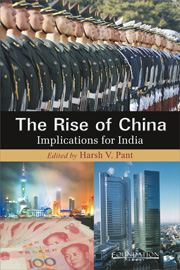Book contents
- Frontmatter
- Contents
- List of Contributors
- Preface
- 1 Introduction
- Part I Domestic Developments in China
- Part II China's Foreign Policy
- 5 China in the Asia-Pacific and Indian Ocean Region: A State of Flux
- 6 China and the United States: Jostling Begins
- 7 China's Resource Diplomacy: India Struggles to Catch-up
- Part III China's India Policy
5 - China in the Asia-Pacific and Indian Ocean Region: A State of Flux
from Part II - China's Foreign Policy
Published online by Cambridge University Press: 05 June 2012
- Frontmatter
- Contents
- List of Contributors
- Preface
- 1 Introduction
- Part I Domestic Developments in China
- Part II China's Foreign Policy
- 5 China in the Asia-Pacific and Indian Ocean Region: A State of Flux
- 6 China and the United States: Jostling Begins
- 7 China's Resource Diplomacy: India Struggles to Catch-up
- Part III China's India Policy
Summary
China's strength alone will not be sufficient, and we shall also have to rely on the support of international forces … this adds to China's tasks in international propaganda and diplomacy
– Selected Military Writings of Mao Tse-Tung, p. 214.
Deliberately creating misconceptions for the enemy and then springing surprise attacks upon him are two ways – indeed two important means – of achieving superiority and seizing the initiative
– Selected Military Writings of Mao Tse-Tung, p. 239.
Adopt a sober perspective; maintain a stable posture; be composed; conserve your strength and conceal your resources; don't aspire to be the head; do something eventually
– Deng Xiaoping's statement, June 1989, cited in D.M. Lampton, The Three Faces of Chinese Power, p. 16.
China's record as a citizen of the world is strikingly threadbare
– Economist, March 21, 2009, p. 13.
This chapter examines the character and scope of changes in China's approach to Asia-Pacific since the late 1990s. The theme is that China's policies towards the region, and the pattern of power and relationships in the region are in a flux; they are not in disarray but they are unsettled and changing constantly. Has China abandoned it strategy (long term tactics) to divide and demoralise its rivals in its declared policy of a peaceful rise? Has it abandoned its strategic aim to form a China-centric hub and to form a structure of dominant-subordinate relationships in Asia?
- Type
- Chapter
- Information
- The Rise of ChinaImplications for India, pp. 107 - 138Publisher: Foundation BooksPrint publication year: 2012
- 1
- Cited by



